Puppies chew. Everyone knows that. In fact, it’s one of the reasons some of us choose to adopt dogs who are at least six months of age – when those nasty needle-sharp puppy teeth are gone and the worst of the chewing is over. But baby dogs are darned cute, and thankfully plenty of dog lovers are willing to suffer through damaged shoes and table legs in order to experience the many joys of puppyhood.
Why do puppies chew? They chew to explore the world, and to relieve the pain and irritation of teething. But they also chew because it’s a natural, normal activity for all canines, young and old. While puppies do eventually grow up and get past the stage where they feel compelled to put their teeth on everything they see, mature dogs also need to chew to exercise their jaws, massage their gums, clean their teeth, and to relieve stress and boredom.
It comes as an unpleasant surprise to many owners that chewing doesn’t end at the age of six or seven months, when all a dog’s adult teeth are grown in. In fact, significant chewing may continue for the first 18 to 24 months of a dog’s life; given the opportunity, most dogs will happily chew into their senior years.
It’s the rare puppy who makes it through the first year of his life without inflicting significant damage to one or more of his human’s valued possessions. But there’s a lot you can do to stop puppy chewing or at least keep damage to a minimum.
Puppy Chewing Management
Ah, yes, management – the answer to so many behavior challenges. Puppies develop chew-object preferences in the early months of their lives, so the better you are at managing your pup’s access to non-chew items and directing him to desired chew objects, the sooner he will earn house freedom. If you give your baby dog the run of the house and he learns to chew on carpets, throw pillows, books, shoes, and coffee table legs, you will likely end up with a dog who chooses to exercise his jaws and teeth on inappropriate objects for years to come. You’ll find yourself crating him frequently even as an adult dog, or worse, exiling him to a life of loneliness in the backyard, where he can “only” chew on patio furniture, potted plants, and the edges of your deck.
If, instead, you provide a variety of approved chew toys at an early age and manage your pup well to prevent access to your stuff, he’ll earn house privileges much sooner. By the end of his first year, you may be able to leave him alone safely while you go out to dinner, shopping – even while you’re away at work.
When you’re home, your puppy needs to always be under your direct supervision – for house-training as well as chew-prevention purposes. You may need to keep him on a leash or a tether, put up baby gates, or simply close the door of the room you’re in so he’s shut in with you and can’t wander into the bedroom to shred your shoes while your back is turned. If you’re too occupied to supervise, put him in his crate or exercise pen to keep him out of trouble.
Good management also requires “puppy-proofing” the house. Don’t leave shoes – a favorite of most unsupervised dogs – where your pup can get them. Put all inviting objects out of his reach, just as you would for a two-year-old toddler. If you can’t put electric cords out of his reach, you can slide them through a piece of PVC pipe or use a commercial product (such as the CritterCord) to prevent cords from getting chewed. The less often you have to intervene to retrieve something from him that he shouldn’t have, the better.
Supply Side
At the same time, give him a generous supply of “legal” chew objects to keep his needle-sharp puppy teeth appropriately occupied. The pet product industry provides an ever-growing list of fascinating chew toys for puppies and adult dogs. (See sidebar) If you consistently supply your pup with desirable and acceptable objects upon which to chew, he’ll eventually develop a strong preference for chewing on those same objects. He will seek out these items when he feels the need to gnaw instead of chewing on the nearest sofa cushion, and eventually your personal possessions will be safe, even when your back is turned.
Because different dogs chew with varying intensity, it’s impossible to make definitive statements about which types of chew products are safe and appropriate for your particular dog. The safety of chew objects such as rawhide, various bones, pig ears, and cow hooves is a hotly debated topic, but the one universal truth is that you must observe your dog with any toy, and take it away from him if he consumes it or chews it in a particularly vigorous way.
For example, rope tugs are wonderful chew toys for some dogs, but others become bent on chewing off and ingesting the strings, risking serious gastrointestinal complications, even death. One dog may chew a dried cow’s hoof on and off for months, whereas another dog may devote himself to destroying and ingesting the entire hoof in a matter of hours – and then spend the next few hours vomiting. A dog who chews rawhide or a pig’s ear for hours, tearing off and swallowing only tiny pieces at a time, probably won’t suffer any ill effects, but the one who tries to gobble down crunchy, sharp shards of the dried ears, or large pieces of rawhide, is bound to end up at the veterinary ER someday.
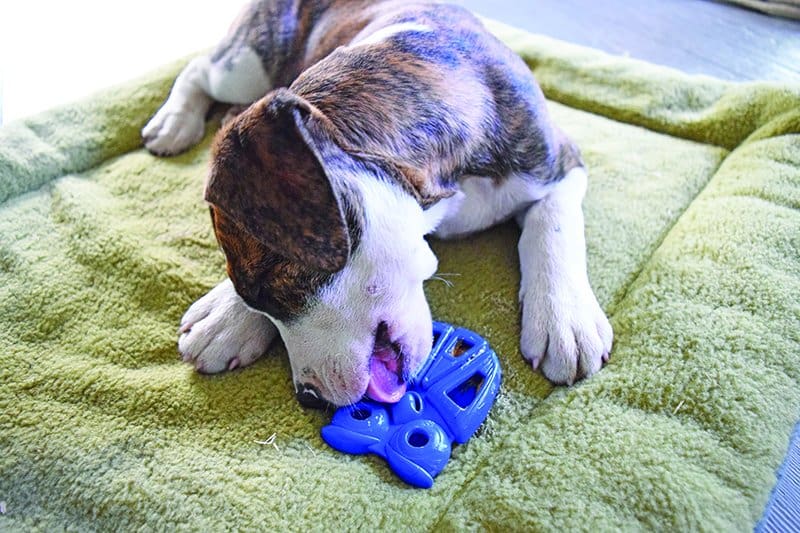
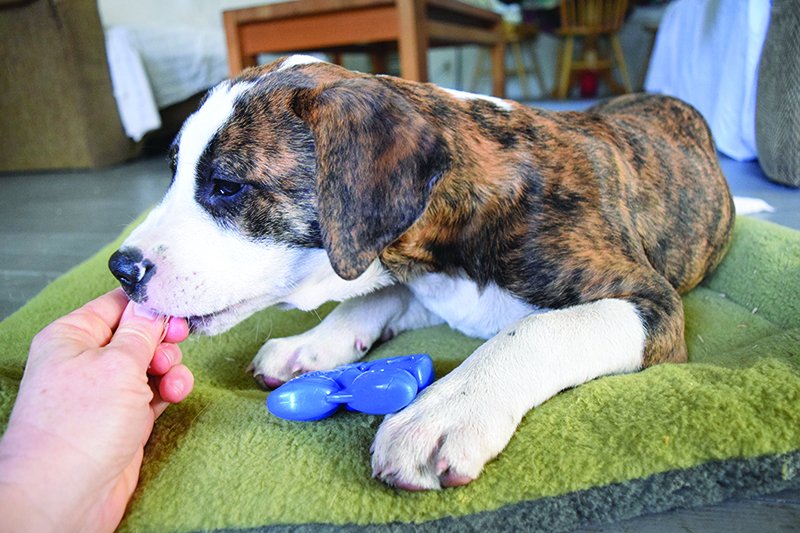
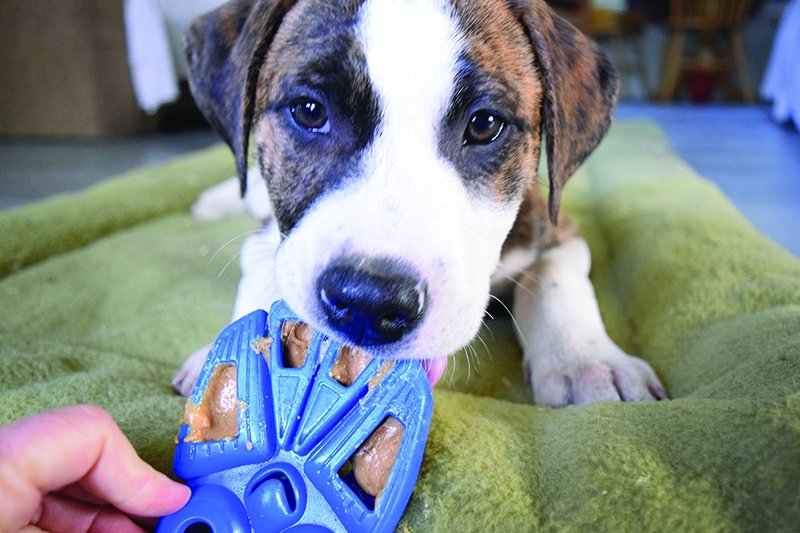
Check with your own veterinarian and follow her recommendations regarding the use of these and other chew items for your dog. Regularly check the condition of any chew toys you give your dog, and discard them when they begin to show signs of wear and tear.
If you give your dog rawhide or bully sticks, buy the largest ones you can find, even comically large, and throw them away when they get chewed down to a size that could possibly be swallowed.
Stop Puppy Chewing With A Great Trade
You can reduce the risk of damage to occasional ill-gotten items by teaching your pup to exchange toys for treats, using something that he’s allowed to have and loves, such as a favorite chew toy, or a food-stuffed Kong.
The key to this game is teaching him that if he gives something up, he gets something better in return, and he gets the original thing back as well. Two rewards for the price of one! Then, on the presumably rare occasion that he has a forbidden object, he’s more likely to bring it to you to trade than to drag his prize to his cave under the dining room table for a leisurely chew. The rare occasion that he doesn’t get “the thing” back won’t be enough to overcome the programming you’ve done by frequently playing the “trade” game with him.
In order for this new programming to take hold, you have to stop playing his game of “chase the puppy” when he grabs the TV remote or some other forbidden object. This is often an attention-getting behavior; he’s learned that grabbing “your” toys and dashing off with them initiates a rousing play session. Dogs and puppies who learn the trade game well can actually help protect your belongings, by bringing things they find on the floor to you, in hopes of a good trade!
Here’s how to teach your dog to trade:
1. Offer your dog a food-stuffed Kong (or another favorite toy) and say, “Take it!” Have him on a leash if you think he’ll run off with it.
2. Give him enough time to get fully engaged in chewing, and then say “Trade!” in a cheerful tone of voice and offer him a handful of irresistible treats, such as small bits of chicken or low-fat cheese. Hold the treats under his nose and let him sniff them.
3. It may take him several seconds to think about it, but eventually he should drop his Kong and start eating the treats. When he drops the Kong, say, “Yes!” But don’t let him eat the treats in one gulp! Hold the tidbits in your hand in such a way that he can only nibble them one by one.
4. While he is still nibbling, reach down with your other hand and pick up the Kong.
5. Let him nibble a bit longer, then offer him the Kong again.
6. Repeat the exercise several times, then end the game by giving him back his Kong and letting him chew to his heart’s content.
Play this game frequently, occasionally when he’s engaged in chewing on his toys on his own, or whenever you feel like initiating the game, until he’ll give up his chew object easily, on your “Trade!” cue.
The trade game doesn’t always go as smoothly as you might like. Here are some of the challenges you may face:
– Your pup may not be willing to drop his toy in exchange for the treats in your hand. Try dropping the treats on the floor in a little Hansel-and-Gretel trail. Many dogs are more willing to give up their valued possession if the treats are within easy reach on the floor. Then, while he is following the trail to your hand that’s still holding a reservoir of treats, pick up the Kong with your other hand.
– Your pup may lose interest in his toy after he realizes you have yummy treats in your hand. Try using less valuable treats, or a more valuable chew toy. Or simply play the game when he already happens to be chewing on one of his toys.
– Your dog may guard valuable resources. If he growls, snaps, or even stiffens and looks tense when you try to trade with him, STOP practicing this exercise and seek the help of a qualified and positive training professional to help you resolve the resource-guarding challenge. Meanwhile, supervise him very closely to prevent his access to forbidden objects so you don’t put yourself at risk for being bitten because you have to take something away from him.
Note: When you teach your dog to trade, he may go through a phase, as did Dubhy, my Scottish Terrier, where he looks for things to bring to you in order to get you to play the game. Humor him. He will probably outgrow this stage, and if he doesn’t, it’s still better to have him bring you things than to carry them off to chew on.
I continue to trade my dogs for a treat when I want something they have throughout their entire lives; it keeps them happy and willing to give things up when I need them to.
Graduating
When you think your young dog is ready, start leaving him unattended for short periods of time – 5, 10, then 15 minutes. If all goes well, gradually increase his alone-time until you can trust him to stay home alone, uncrated, as part of your regular daily routine.
Like so many things worth having, your investment of time and energy will help your pup grow up to be the trustworthy and beloved family member you want him to be. You will be able to relax at work, and sleep well at night, knowing your valuables are safe from your canine’s canines. Your shoes will thank you for it.
Read Next: Puppy Potty Training: Simple, But Not Easy


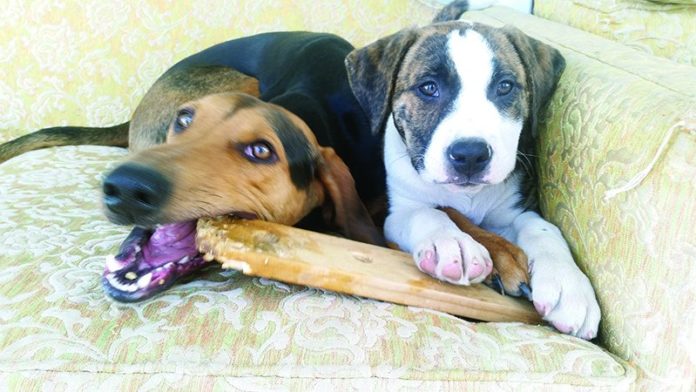

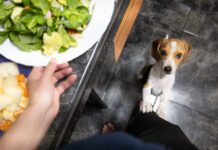
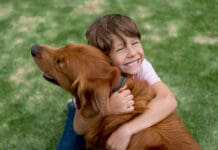
Looking for the recommended list of fascinating chew toys for puppies in the referenced “sidebar”, but don’t see it here. Can you help? Thanks!
“The pet product industry provides an ever-growing list of fascinating chew toys for puppies and adult dogs. (See sidebar) If you consistently supply your pup with desirable and acceptable objects upon which to chew, he’ll eventually develop a strong preference for chewing on those same objects.”
This is a question more than a comment….My 10 month old, 80lbs, golden retriever Abe, love bully sticks, he has from the beginning. When he was younger it took him a lot longer sometimes days to chew it up. I took it away when is got small, 5-6 inches. Now he devours them in about an hour or so and nothing is left. So I am now assuming he chewed it up into small enough pieces and then swallowed. I am not sure now . This behavior has been going on for about 2 months. He gets bully sticks pretty often usually in the evening after dinner. He is the most restless then, and gets into “trouble” looking for things to chew and bothering us while we are watching tv or reading. We are home with him in the daytime (my husband and I are retired) so he gets frequent walks, playtime and training time off and on during the day. But evening he is restless. I am now getting concerned about how many bully sticks are ok and if its ok to let him finish them off?